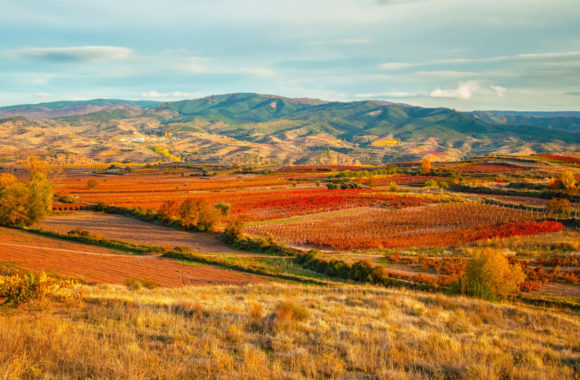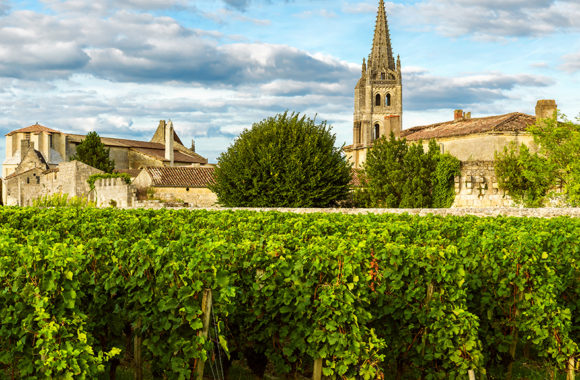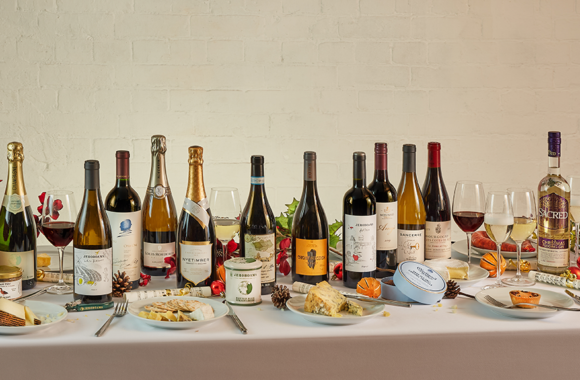
An Introduction To: New Zealand
· Maggie Macpherson Maggie Macpherson on
Jeroboams Education is a new series on our blog providing you with the lowdown on the most iconic wine producing regions of the world. Led by our super buying team, Peter Mitchell MW and Maggie MacPherson will introduce you to the key facts and a little history of all the regions you recognise but perhaps don’t know too well. To help really further your education, why not drink along? Browse our New Zealand selection.
Introduction
“ It’s a dangerous business, Frodo, going out your door.”
You have to allow me at least one Lord of the Rings quote when we’re talking about New Zealand. A country of varied landscapes and dramatic geographical features including glaciers, placid lakes, live volcanoes and of course the vast mountain ranges. The wines produced in New Zealand are as wide-ranging as its landscape which is why we Brits have fallen in love with New Zealand wines. Our love of Marlborough Sauvignon Blanc has been well documented, and continues to inspire the question, what next? However, top Pinot Noirs, Chardonnays and Syrah are slowly making their way into Mainstream outlets in the UK as we continue to explore our love affair with this eclectic couple of islands. It’s a good thing we love the wines so much given New Zealand’s domestic drinks market has historically been dominated by beer and still is to this day, with consumption 3.5 times that of wine.
History
New Zealand’s first vines were planted in 1819, however it took until the 1840s for James Busby, a British resident, to make New Zealand’s first recorded wine. Domestic wine consumption was mostly of Australian imports until 1958 when the government introduced tariffs, allowing local producers to compete with the more established Australian brands. From the first plantings in 1973, Marlborough has been the epicentre of New Zealand’s wine industry and still accounts for 70% of all New Zealand’s land under vine. This kicked off a rapid expansion in land under vine culminating in 1983 with an enormous harvest creating a surplus collapsing prices and leading to a vine pull scheme, although this was short-lived. Weirdly, at this point, Müller Thurgau was the most planted white grape variety and quality was relatively average until the mid-1980’s, when Dr Richard Smart’s canopy management techniques were introduced to promote ripeness through stripping the canopy and focusing the vines efforts on the fruit rather than growing lots of leaves.
It’s difficult to discuss New Zealand’s wine history without talking about Sauvignon Blanc, however it was only introduced in the late 1970’s, now it accounts for 63% of New Zealand’s vineyard area. However, it is still primarily planted in Marlborough with Marlborough Sauvignon Blanc accounting for 56% of land under vine in New Zealand – we don’t call it a “Savalanche” for nothing… In 1960 total production was around 450,000 cases, by 1983 that stood at 6.4m cases and by 2019 this has risen to 33m cases! That represents an increase of 400% in just under 40 years. As an agricultural country without a long history of wine production and who have felt considerable Australian influence in their wine industry, it is unspringing that there is a cult of the winemaker here rather than one of terroir. Although there are now estates focusing on individual sites and terroirs, most wine remains an agricultural product, made with minimised risks and with the winemaker’s stamp visible on the finished product.
Climate and Soil
New Zealand lies between 34° and 46° South, to put this in a European context, it is the equivalent area of Tunisia to the Southern tip of Burgundy. However, don’t be fooled into thinking New Zealand enjoys the same climate as its northern counterparts. The cooler ocean currents make New Zealand colder and wetter, for example, Hawke’s Bay, which is the same distance from the equator as Puglia, has a climate more like that of Bordeaux. Another misleading index is the heat summation figures, although often useful in other countries, it doesn’t consider the lack of cloud cover in summer and this intense sunlight can ripen fruit in areas that would seem too cold on paper.
New Zealand is a country of extremes with the broadest distinction being between the warmer North and cooler South Islands. The far north has a sub-tropical climate, whilst Central Otago is cool continental. New Zealand is a mountainous and wet country, which whilst excellent for pasture, can be problematic for vines, with excessive vegetation growth which can hinder ripeness and encourage fungal diseases. For this reason, wine regions are mainly focused in the rain shadow of the mountains.
In most regions, soils are fertile and there is no shortage of rainfall, which can encourage vines to grow excessive foliage at the expense of fruit development if a strict canopy management system is not used. Most wine production takes place on alluvial river valleys and plains, with the deposits typically being old decomposed sandstone mixed with some limestone. Despite the damp climate, these free draining soils can sometimes lead to water stress in dry periods in summer and as such irrigation is widely practiced in many regions.
The Regions of New Zealand

The Key Sub-regions of New Zealand
Marlborough
The largest and most famous of New Zealand’s wine regions is located in the far North of the South Island and was first planted by Montana (now Brancott Estate) in 1973. It is made up of two broad flat river valleys, the Wairau and the Awatere. Soils and microclimates vary considerably, leading to significant differences in ripeness and fruit character, but in general, soils in the lower Wairau are lighter and stonier and produce less rounded and somewhat pungent wines, whilst further up the valley the deeper, heavier soils produce richer, more textural and more concentrated wines. The Upper Wairau was the original area planted around Renwick and Rapaura, which is home today to many of the finest historic estates such as Cloudy Bay, Greywacke and Hunter’s. The Awatere, first championed by Vavasour, is located to the south of the Wairau, is somewhat cooler and produces wines that are leaner and flintier in style. There has been very considerable planting in the Awatere over the past 5 years by big branded producers, most notably Yealands who boast New Zealand’s single largest privately-owned vineyard. Nearly 90% of the country’s Sauvignon Blanc is grown in Marlborough and it is a style recognised the world over, with its blend of tropical fruit flavours and herbaceous, capsicum notes.
Whilst 79% of Marlborough’s vineyard is taken up by Sauvignon, there are also significant and growing plantings of Pinot Noir, (10%) Chardonnay (4%), Pinot Gris (4%) and a few hundred hectares of Riesling and other aromatics. Sauvignon dominates the Marlborough wine landscape, but the quality of Pinot Noir and Chardonnay has increased dramatically over the last decade.
Central Otago
The world’s most southerly vineyard, it is the only New Zealand region with a continental climate. The first vines were only planted in the 1980’s and the region is dominated by pinot noir (with 79% of the planted hectarage). Other varieties planted are Pinot Gris (10%), Riesling (4%), Chardonnay (3%) and Sauvignon Blanc (2%) and a small amount of Gewurztraminer. Vineyards are planted on valley slopes to catch maximum sunshine and reduce spring frost risk. There are 6 sub-zones in Otago, the original being Bannockburn, which is one of the warmest and arguably the best. Nearby are Alexandra and Cromwell, both of which show great potential and Bendigo, the warmest region and the one undergoing the heaviest planting. Gibbston and Wanaka are the final two, cooler and later ripening and making wines with perhaps greater elegance. Central Otago pinot is intensely fruity and decidedly voluptuous, often with creamy tannins. It has rapidly established itself as a premium region in the eyes of international consumers, however with so many young vines and new vineyards, the real potential here is yet to be achieved.
Canterbury/Waipara
Occupying the central east coast of the South Island, this is a geographically wide region, with some vineyards around Christchurch itself and a few experimental plantings in the Waitaki valley on the Otago border in the far south, however most of the production is centred around Waipara an hour north of Christchurch. Waipara is cool and dry and whilst spring and autumn frosts are a hazard, wines from here have a bright acidity and elegance. Pinot noir is the most important variety, with 29% of plantings, followed by sauvignon Blanc (27%), Riesling (21%), Pinot Gris (14%) and chardonnay (6%)
Nelson
In the far north of the South Island, Nelson is generally slightly cooler and wetter than Marlborough, although in many years it is slightly sunnier. Wine production is centred around the town of Nelson, in the Moutere Hills to the northwest and the expanding Waimea plains to the south. Moutere produces wines of more substance and structure, whilst Waimea makes prettier, softer styles. Sauvignon Blanc is the main variety with 48% of plantings, followed by Pinot Noir (21%), Pinot Gris (12%), Chardonnay (8%) plus a little Riesling and Gewürztraminer.
Hawke’s Bay
Located on the eastern coast of the North Island around the town of Napier, famous for its art deco architecture as the town was completely rebuilt in 1931 after a devasting earthquake. The region is one of the most historic and has many varying terroirs. It is known as the fruit bowl, with its fertile soils suited to the production of stone fruits, though the original grapevine plantings in these fertile areas have led to excessive vigour resulting in poor ripeness. However, from the mid 1980’s, planting has focused on very poor gravelly soils of an old riverbed and most famously the Gimblet Gravels, an 800-hectare area of deep gravel soil ideally suited to the production of fine Cabernet Sauvignon, Merlot and Syrah. Hawke’s bay is the main source of Bordeaux varietals and Syrah, with 88% of the country’s production coming from here. Chardonnay grown here tends to be quite opulent, whilst Sauvignon Blanc is very ripe, with flavours of nectarine and quite often a touch of oak. There is also a small amount of rich and spicy Pinot Gris and full, supple Pinot Noir.
Gisbourne
Located north of Hawke’s Bay on the eastern coast of the North Island this warm region has been in decline for over a decade, with production nearly halving on the back of Pernod-Ricard ending its association with the area. Much of the production is shipped to Auckland for processing although there are several boutique wineries here such as the excellent Milton Vineyards, pioneers of organic and biodynamic viticulture in New Zealand. Chardonnay is the most important variety, producing very tropical styles, whilst hefty Gewürztraminer is also made in significant quantities. Other varieties grown are Viognier, Malbec, Merlot and Pinot Gris.
Wairarapa
In the far south of the North Island, Wairarapa includes the fine region of Martinborough. This region is the home of the boutique winery, with under 3% of the country’s vineyard, but with nearly 10% of its wineries. This may explain why some of the country’s best, but also hardest to find wines are made here. The climate is less sunny and wetter than Marlborough (it is similar to that of Burgundy), with gravel soils. Mostly because of the nature of the producers, there is a quality first attitude here, meaning yields are the lowest in the country and there is a strong argument that the finest wines in all of New Zealand come from this small region, with iconic names such as Dry River, Ata Rangi, and Craggy Range. Pinot Noir makes up 50% of the vineyard, Sauvignon Blanc 32%, Pinot Gris 6%, Riesling 3%, with the rest Syrah, Chardonnay, Viognier and Gewürztraminer.
Auckland/Northland In the north of the North Island, this region was the cradle of New Zealand wine, however it seemed finished in the 1980’s with the rise of Hawke’s Bay and Marlborough. With a very warm and wet climate, excessive vine vigour and disease meant it was hard to make wine of quality. However, better vineyard techniques in the 1990’s coupled with some newly planted subregions, most especially Waiheke Island, breathed new life into the region. Although production is small, the region is now home to some of the most sought after and expensive wines in the country such as Stonyridge and Man O’War. Bordeaux blends tend to density, yet not without finesse, whilst Chardonnay is both exotic and fresh. Waiheke Syrah shows world class promise, with great aromatics and freshness. Bordeaux varietals make up 50% of the vineyard, Chardonnay 18%, Syrah 14% and Pinot Gris 9%.
Market
Despite headlines covering New Zealand’s vast production of Sauvignon Blanc, New Zealand is still a small player in global production, lying in 16th place with 1.02% of the world’s total production (just behind Brazil, in 2018 rankings). The UK has been an enthusiastic importer of New Zealand wines, second only to the US, importing $470m worth of New Zealand wine in 2019, up 10% on 2018. Exports have always been important for New Zealand, but they are even more important now as their domestic market contracts, declining by 8% in 2019.
Vintages
2009: Good quality throughout New Zealand, with Martinborough and Hawkes Bay reds fairing particularly well.
2010: Smaller vintage but good concentration, particularly in Sauvignon Blanc.
2011: A warm and wet season causing fungal issues and compromising quality.
2012: Cold, cold, cold. Affecting yields which were down 18%. Sauvignon Blancs are particularly lean.
2013: Lauded as the best vintage in Hawkes Bay with a long warm summer and no adverse weather.
2014: Good news all round, but particularly in Hawkes Bay and Marlborough with its largest vintage yet and good quality.
2015: Dry conditions in Marlborough producing wines with greater concentration however yields down 20- 25%.
2016: Good size of production, with Martinborough enjoying excellent conditions throughout.
2017: Small harvest, up to 9% lower than 2016 with wet and cool conditions causing a late harvest in Marlborough.
2018: Rain in Marlborough caused rot issues during harvest reducing yields, but the warm summer meant yields were better to start with than 2017.
2019: Another small vintage, but quality is high with modest alcohol, sharp acidity and strong varietal characters.







